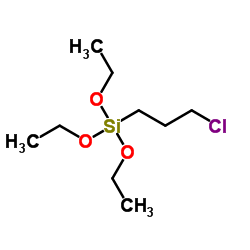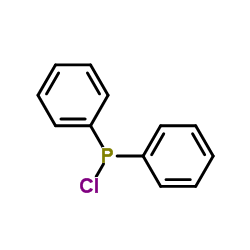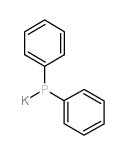DIPHENYL[3-(TRIETHOXYSILYL)PROPYL]PHOSPHINE
Modify Date: 2024-02-29 08:05:17
![DIPHENYL[3-(TRIETHOXYSILYL)PROPYL]PHOSPHINE Structure](https://image.chemsrc.com/caspic/311/52090-23-0.png)
DIPHENYL[3-(TRIETHOXYSILYL)PROPYL]PHOSPHINE structure
|
Common Name | DIPHENYL[3-(TRIETHOXYSILYL)PROPYL]PHOSPHINE | ||
|---|---|---|---|---|
| CAS Number | 52090-23-0 | Molecular Weight | 390.52800 | |
| Density | N/A | Boiling Point | N/A | |
| Molecular Formula | C21H31O3PSi | Melting Point | N/A | |
| MSDS | N/A | Flash Point | N/A | |
| Name | diphenyl(3-triethoxysilylpropyl)phosphane |
|---|
| Molecular Formula | C21H31O3PSi |
|---|---|
| Molecular Weight | 390.52800 |
| Exact Mass | 390.17800 |
| PSA | 41.28000 |
| LogP | 4.55780 |
|
Section 1: Product Identification Chemical Name:Diphenyl[3-(triethoxysilyl)propyl]phosphine, 98% CAS Registry Number:52090-23-0 Formula:(C6H5)2P(CH2)3Si(OCH2CH3)3 EINECS Number:none Chemical Family:organophosphine ligand Synonym:none
Section 2: Composition and Information on Ingredients IngredientCAS NumberPercentACGIH (TWA)OSHA (PEL) Title compound52090-23-0100%no datano data Section 3: Hazards Identification Emergency Overview:Irritating to skin, eyes and respiratory tract. Primary Routes of Exposure:Ingestion, inhalation, skin, eyes Eye Contact:Causes irritation of the eyes. Skin Contact:Causes irritation of the skin. Inhalation:Irritating to the nose, mucous membranes and respiratory tract. Ingestion:No information available on the physiological effects of ingestion. May be harmful if swallowed. Acute Health Affects:Irritating to skin, eyes and respiratory tract. Chronic Health Affects:No information on long-term chronic effects. NTP:No IARC:No OSHA:No SECTION 4: First Aid Measures Immediately flush the eyes with copious amounts of water for at least 10-15 minutes. A victim may need Eye Exposure: assistance in keeping their eye lids open. Get immediate medical attention. Wash the affected area with water. Remove contaminated clothes if necessary. Seek medical assistance if Skin Exposure: irritation persists. Remove the victim to fresh air. Closely monitor the victim for signs of respiratory problems, such as difficulty Inhalation: in breathing, coughing, wheezing, or pain. In such cases seek immediate medical assistance. Seek medical attention immediately. Keep the victim calm. Give the victim water (only if conscious). Induce Ingestion: vomiting only if directed by medical personnel. SECTION 5: Fire Fighting Measures Flash Point:none Autoignition Temperature:none Explosion Limits:none Extinguishing Medium:carbon dioxide, dry powder or foam If this product is involved in a fire, fire fighters should be equipped with a NIOSH approved positive pressure Special Fire Fighting Procedures: self-contained breathing apparatus and full protective clothing. Hazardous Combustion andIf involved in a fire this material may emit toxic organic fumes and vapors of phosphorus pentoxide. Decomposion Products: Unusual Fire or Explosion Hazards: No unusual fire or explosion hazards. SECTION 6: Accidental Release Measures Spill and Leak Procedures:Small spills can be mixed with vermiculite or sodium carbonate and swept up. SECTION 7: Handling and Storage Material may degrade over time on exposure to air. Handle and store under an inert atmosphere of nitrogen or Handling and Storage: argon. SECTION 8: Exposure Controls and Personal Protection Eye Protection:Always wear approved safety glasses when handling a chemical substance in the laboratory. Skin Protection:Wear protective clothing and gloves. Ventilation:Handle the material in an efficient fume hood. If ventilation is not available a respirator should be worn. The use of respirators requires a Respirator Respirator: Protection Program to be in compliance with 29 CFR 1910.134. Ventilation:Handle the material in an efficient fume hood. Additional Protection:No additional protection required. SECTION 9: Physical and Chemical Properties Color and Form:colorless, oily liquid Molecular Weight:390.53 Melting Point:no data Boiling Point:no data Vapor Pressure:no data Specific Gravity:no data Odor:not determined Solubility in Water:insoluble SECTION 10: Stability and Reactivity Stability:air sensitive, moisture sensitive Hazardous Polymerization:no hazardous polymerization Conditions to Avoid:prolonged exposure to air Incompatibility:oxidizing agents and halogens Decomposition Products:carbon monoxide, carbon dioxide, phosphorous oxides and organic fumes SECTION 11: Toxicological Information RTECS Data:No information available in the RTECS files. Carcinogenic Effects:No data Mutagenic Effects:No data Tetratogenic Effects:No data SECTION 12: Ecological Information Ecological Information:No information available SECTION 13: Disposal Considerations Disposal:Dispose of according to local, state and federal regulations. SECTION 14: Transportation Shipping Name (CFR):Non-hazardous Hazard Class (CFR):NA Additional Hazard Class (CFR):NA Packaging Group (CFR):NA UN ID Number (CFR):NA Shipping Name (IATA):Non-hazardous Hazard Class (IATA):NA Additional Hazard Class (IATA):NA Packaging Group (IATA):NA UN ID Number (IATA):NA SECTION 15: Regulatory Information TSCA:Not listed in the TSCA inventory SARA (Title 313):Title compound not listed Second Ingredient:none SECTION 16 - ADDITIONAL INFORMATION N/A |
| HS Code | 2931900090 |
|---|
|
~% ![DIPHENYL[3-(TRIETHOXYSILYL)PROPYL]PHOSPHINE Structure](https://image.chemsrc.com/caspic/311/52090-23-0.png)
DIPHENYL[3-(TRI... CAS#:52090-23-0 |
| Literature: Bogar, Krisztian; Krumlinde, Patrik; Bacsik, Zoltan; Hedin, Niklas; Baeckvall, Jan-E. European Journal of Organic Chemistry, 2011 , # 23 p. 4409 - 4414 |
|
~% ![DIPHENYL[3-(TRIETHOXYSILYL)PROPYL]PHOSPHINE Structure](https://image.chemsrc.com/caspic/311/52090-23-0.png)
DIPHENYL[3-(TRI... CAS#:52090-23-0 |
| Literature: Castro, Alichandra; Alonso, Joao C.; Valente, Anabela A.; Neves, Patricia; Brandao, Paula; Felix, Vitor; Ferreira, Paula European Journal of Inorganic Chemistry, 2010 , # 9 p. 1405 - 1412 |
| Precursor 3 | |
|---|---|
| DownStream 0 | |
| HS Code | 2931900090 |
|---|---|
| Summary | 2931900090. other organo-inorganic compounds. VAT:17.0%. Tax rebate rate:13.0%. Supervision conditions:AB(certificate of inspection for goods inward,certificate of inspection for goods outward). MFN tariff:6.5%. General tariff:30.0% |



